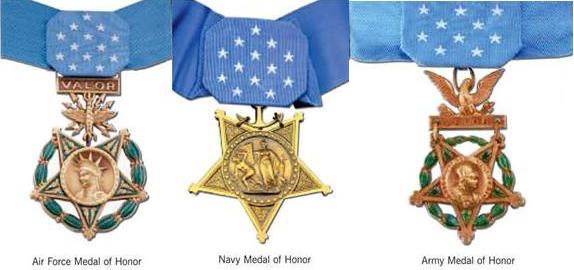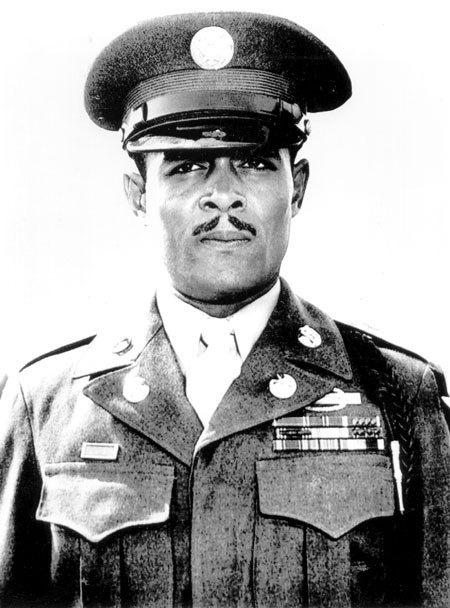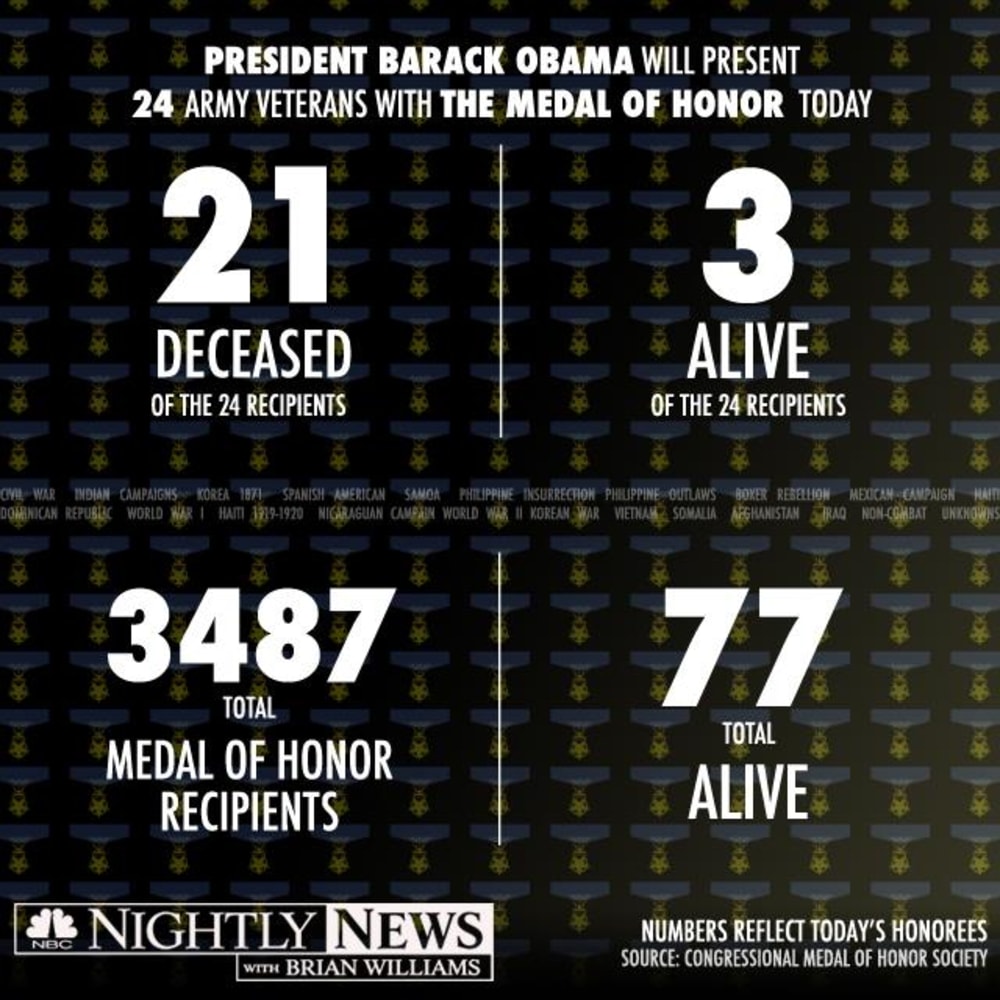


Medal of Honor
| Medal of Honor | |
|---|---|

Army, Navy, and Air Force versions of the Medal of Honor
|
|
| Awarded by the President of the United Statesin the name of the U.S. Congress | |
| Type | U.S. military medal with neck ribbon (Decoration) |
| Eligibility | Military personnel only |
| Awarded for | Conspicuous gallantry and intrepidity at the risk of life above and beyond the call of duty |
| Status | Currently awarded |
| Statistics | |
| Established | U.S. Navy: December 21, 1861 U.S. Army: July 12, 1862 U.S. Air Force: April 14, 1965 |
| First awarded | March 25, 1863: American Civil War, U.S. Army recipient |
| Last awarded | July 31, 2017 |
| Total awarded | 3,516 |
| Posthumous awards |
621 |
| Distinct recipients |
3,497[ |
| Precedence | |
| Next (higher) | None |
| Next (lower) | Army: Distinguished Service Cross Navy and Marine Corps: Navy Cross Air Force: Air Force Cross Coast Guard: Coast Guard Cross |
The Medal of Honor is the United States of America’s highest and most prestigious personal military decoration that may be awarded to recognize U.S. military service members who distinguished themselves by acts of valor.
The medal is normally awarded by the President of the United States in the name of the U.S. Congress.
There are three versions of the medal, one for the Army, one for the Navy, and one for the Air Force.[6] Personnel of the Marine Corps and Coast Guard receive the Navy version.
U.S. awards, including the Medal of Honor, do not have post-nominal titles, and while there is no official abbreviation, the most common abbreviations are “MOH” and “MH”. The Medal of Honor is the oldest continuously issued combat decoration of the United States armed forces.
The Medal of Honor was created as a Navy version in 1861 named the “Medal of Valor”, and an Army version of the medal named the “Medal of Honor” was established in 1862 to give recognition to men who distinguished themselves “conspicuously by gallantry and intrepidity” in combat with an enemy of the United States.
Because the medal is presented “in the name of Congress”, it is often referred to as the “Congressional Medal of Honor”. However, the official name is “Medal of Honor”, which began with the U.S. Army’s version.
Within United States Code the medal is referred to as the “Medal of Honor”, and less frequently as “Congressional Medal of Honor”.
The President normally presents the Medal of Honor at a formal ceremony in Washington, D.C. which is intended to represent the gratitude of the American people, with posthumous presentations made to the primary next of kin.
According to the Medal of Honor Historical Society of the United States, there have been 3,516 Medals of Honor awarded to the nation’s soldiers, sailors, airmen, Marines, and Coast Guardsmen since the decoration’s creation, with just less than half of them awarded for actions during the four years of the American Civil War.
In 1990, Congress designated March 25 annually as “National Medal of Honor Day”.[17] Due to its prestige and status, the Medal of Honor is afforded special protection under U.S. law against any unauthorized adornment, sale, or manufacture, which includes any associated ribbon or badge.
Contents
[hide]
- 1History
- 2Appearance
- 3Neck ribbon, service ribbon, and lapel button
- 4Devices (none)
- 5Medal of Honor Flag
- 6Presenting
- 7Authority and privileges
- 8Legal protection
- 9Duplicate medals
- 10Recipients
- 1127th Maine and other revoked awardings
- 12Similar American decorations
- 13See also
- 14References
- 15External links
History
1780: The Fidelity Medallion was a small medal worn on a chain around the neck, similar to a religious medal, that was awarded only to three militiamen from New York state, for the capture of John André, a British officer and spy connected directly to General Benedict Arnold during the American Revolutionary War. The capture saved the fort of West Point from the British Army.[citation needed]
1782: Badge of Military Merit: The first formal system for rewarding acts of individual gallantry by American soldiers was established by George Washington when he issued a field order on August 7, 1782, for a Badge of Military Merit to recognize those members of the Continental Army who performed “any singular meritorious action”.
This decoration is America’s first combat decoration and was preceded only by the Fidelity Medallion, the Congressional medal for Henry Lee awarded in September 1779 in recognition of his attack on the British at Paulus Hook, the Congressional medal for General Horatio Gates awarded in November 1777 in recognition of his victory over the British at Saratoga, and the Congressional medal for George Washington awarded in March 1776.[1][19][20]
Although the Badge of Military Merit fell into disuse after the American Revolutionary War, the concept of a military award for individual gallantry by members of the U.S. Armed Forces had been established.
1847: Certificate of Merit: After the outbreak of the Mexican-American War (1846–1848) a Certificate of Merit (Meritorious Service Citation Certificate) was established by Act of Congress on March 3, 1847 “to any private soldier who had distinguished himself by gallantry performed in the presence of the enemy”.
539 Certificates were approved for this period. The certificate was discontinued and reintroduced in 1876 effective from June 22, 1874 to February 10, 1892 when it was awarded for extraordinary gallantry by private soldiers in the presence of the enemy.
From February 11, 1892 through July 9, 1918 (Certificate of Merit disestablished) it could be awarded to members of the Army for distinguished service in combat or noncombat; from January 11, 1905 through July 9, 1918 the certificate was granted medal status as the Certificate of Merit Medal[21] (first awarded to a soldier who was awarded the Certificate of Merit for combat action on August 13, 1898).
This medal was later replaced by the Army Distinguished Service Medal which was established on January 2, 1918 (the Navy Distinguished Service Medal was established in 1919). Those Army members who held the Distinguished Service Medal in place of the Certificate of Merit could apply for the Army Distinguished Service Cross(established 1918) effective March 5, 1934.
Medal of Valor

Medal of Honor (without the suspension ribbon) awarded to Seaman John Ortega in 1864 (back view of medal).
The only military award or medal at the beginning of the Civil War (1861–1865) was the Certificate of Merit, which was awarded for the Mexican-American War.
In the fall of 1861, a proposal for a battlefield decoration for valor was submitted to Winfield Scott, the general-in-chief of the army, by Lt. Colonel Edward D. Townsend, an assistant adjutant at the War Department and Scott’s chief of staff.
Scott, however, was strictly against medals being awarded, which was the European tradition. After Scott retired in October 1861, the Secretary of the Navy, Gideon Welles, adopted the idea of a decoration to recognize and honor distinguished naval service.
On 9 December 1861, U.S. Senator (Iowa) James W. Grimes, Chairman on the Committee on Naval Affairs,[22] proposed Public Resolution Number 82[23] (Bill 82: 37th Congress, Second Session, 12 Stat. 329) “to promote the efficiency of the Navy” which included a provision for a Navy Medal of Valor.]
Which was signed into law by President Abraham Lincoln on December 21, 1861 (Medal of Valor had been established for the Navy), “to be bestowed upon such petty officers, seamen, landsmen, and marines as shall most distinguish themselves by their gallantry and other seamen-like qualities during the present war.”[]
Secretary Wells directed the Philadelphia Mint to design the new military decoration.[26][27][28] On May 15, 1862, the United States Navy Department ordered 175 medals ($1.85 each) with the words “Personal Valor” on the back from the U.S. Mint in Philadelphia.
Medal of Honor
Senator Henry Wilson, the chairman of the Senate Committee on Military Affairs, introduced a resolution on February 15, 1862 for an Army Medal of Honor. The resolution (37th Congress, Second Session, 12 Stat. 623) was approved by Congress and signed into law on July 12, 1862 (“Medals of Honor” were established for enlisted men of the Army).
This measure provided for awarding a medal of honor “to such non-commissioned officers and privates as shall most distinguish themselves by their gallantry in action and other soldier-like qualities during the present insurrection.”
During the war, Townsend would have some medals delivered to some recipients with a letter requesting acknowledgement of the “Medal of Honor”.
The letter written and signed by Townsend on behalf of the Secretary of War, stated that the resolution was “to provide for the presentation of medals of honor to the enlisted men of the army and volunteer forces who have distinguished or may distinguish themselves in battle during the present rebellion.”
By mid-November the War Department contracted with Philadelphia silversmith Willi
The Army version had “The Congress to” written on the back of the medal. Both versions were made of copper and coated with bronze, which “gave them a reddish tint”.[33][34]
1863: Congress made the Medal of Honor a permanent decoration. On March 3, Medals of Honor were authorized for officers of the Army[35][36] (37th Congress, Third Session, 12 Stat. 751). The Secretary of War first presented the Medal of Honor to six Union Army volunteers on March 25, 1863 in his office.[37]
1890: On April 23, the Medal of Honor Legion is established in Washington, D.C.[38][39][40]
1896: The ribbon of the Army version Medal of Honor was redesigned with all stripes being vertical.[41]
1904: The planchet of the Army version of the Medal of Honor was redesigned by General George Lewis Gillespie.[41] The purpose of the redesign was to help distinguish the Medal of Honor from other medals,[42] particularly the membership insignia issued by the Grand Army of the Republic.
1915: On March 3, Navy, Marine Corps, and Coast Guard officers became eligible for the Medal of Honor.
1963: A separate Coast Guard medal was authorized in 1963, but not yet designed or awarded.[46]
1965: A separate design for a version of the medal for the U.S. Air Force was created in 1956, authorized in 1960, and officially adopted on April 14, 1965. Previously, members of the U.S. Army Air Corps, U.S. Army Air Forces, and the U.S. Air Force received the Army version of the medal.
Appearance
There are three versions of the Medal of Honor, one for each of the military departments of the Department of Defense: Army, Navy, and Air Force. Members of the Marine Corps and Coast Guard are eligible to receive the Navy version.
Each is constructed differently and the components are made from gilding metals and red brass alloys with some gold plating, enamel, and bronze pieces.
The United States Congress considered a bill in 2004 which would require the Medal of Honor to be made with 90% gold, the same composition as the lesser-known Congressional Gold Medal, but the measure was dropped.
Army Medal of Honor
The Army version is described by the Institute of Heraldry as “a gold five pointed star, each point tipped with trefoils, 1 1⁄2 inches [3.8 cm] wide, surrounded by a green laurel wreath and suspended from a gold bar inscribed VALOR, surmounted by an eagle.
In the center of the star, Minerva‘s head surrounded by the words UNITED STATES OF AMERICA. On each ray of the star is a green oak leaf. On the reverse is a bar engraved THE CONGRESS TO with a space for engraving the name of the recipient.”[49]
The pendant and suspension bar are made of gilding metal, with the eye, jump rings, and suspension ring made of red brass.[50] The finish on the pendant and suspension bar is hard enameled, gold plated, and rose gold plated, with polished highlights.
The Navy version is described as “a five-pointed bronze star, tipped with trefoils containing a crown of laurel and oak. In the center is Minerva, personifying the United States, standing with left hand resting on fasces and right hand holding a shield blazoned with the shield from the coat of arms of the United States. She repulses Discord, represented by snakes. The medal is suspended from the flukes of an anchor.” It is made of solid red brass, oxidized and buffed.
Air Force Medal of Honor
The Air Force version is described as “within a wreath of green laurel, a gold five-pointed star, one point down, tipped with trefoils and each point containing a crown of laurel and oak on a green background. Centered on the star, an annulet of 34 stars is a representation of the head of the Statue of Liberty.
The star is suspended from a bar inscribed with the word VALOR above an adaptation of the thunderbolt from the Air Force Coat of Arms.”[49] The pendant is made of gilding metal.[52] The connecting bar, hinge, and pin are made of bronze.[52] The finish on the pendant and suspension bar is hard enameled, gold plated, and rose gold plated, with buffed relief.[52]
Historical versions
The Medal of Honor has evolved in appearance over time. The upside-down star design of the Navy versions pendant adopted in early 1862 has not changed since its inception.
The Army 1862 version followed and was identical to the Navy version except an eagle perched atop cannons was used instead of an anchor to connect the pendant to the suspension ribbon.
In 1896, the Army version changed the ribbon’s design and colors due to misuse and imitation by nonmilitary organizations.[49]
In 1904, the Army “Gillespie” version introduced a smaller redesigned star and the ribbon was changed to the light blue pattern with white stars seen today.[49] In 1913, the Navy version adopted the same ribbon pattern.
After World War I, the Navy decided to separate the Medal of Honor into two versions, one for combat and one for non-combat. The original upside-down star was designated as the non-combat version and a new pattern of the medal pendant, in cross form, was designed by the Tiffany Company in 1919.
It was to be presented to a sailor or Marine who “in action involving actual conflict with the enemy, distinguish[es] himself conspicuously by gallantry and intrepidity at the risk of his life above and beyond the call of duty”[53] Despite the “actual conflict” guidelines—the Tiffany Cross was awarded to Navy CDR (later RADM) Richard E. Byrd and Floyd Bennett for arctic exploration.
The Tiffany Cross itself was not popular. In 1942, the Navy returned to using only the original 1862 inverted 5-point star design, and ceased issuing the award for non-combat action.[54]
In 1944, the suspension ribbons for both the Army and Navy version were replaced with the now familiar neck ribbon.[49]
When the Air Force version was designed in 1956, it incorporated similar elements and design from the Army version.
It used a larger star with the Statue of Liberty image in place of Minerva on the medal and changed the connecting device from an eagle to an heraldic thunderbolt flanked with wings as found on the service seal.[55][56]







